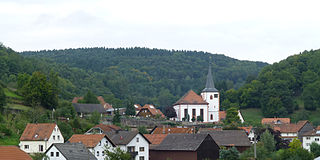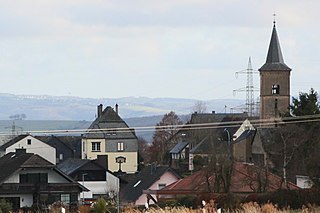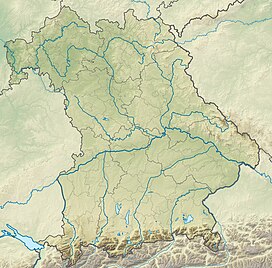
Landkreis (district) Ebersberg is located in Upper Bavaria, Germany. It is bounded by the districts of Erding, Mühldorf, Rosenheim and Munich.
Landsberg am Lech is a Landkreis (district) in Bavaria, Germany. It is bounded by the districts of Aichach-Friedberg, Fürstenfeldbruck, Starnberg, Weilheim-Schongau, Ostallgäu and Augsburg.

Forst an der Weinstraße is an Ortsgemeinde – a municipality belonging to a Verbandsgemeinde, a kind of collective municipality – in the Bad Dürkheim district in Rhineland-Palatinate, Germany.

Forst (Lausitz) (German) or Baršć (Łužyca) (Lower Sorbian, pronounced[ˈbarɕtɕˈwuʒɨtsa]) is a town in Lower Lusatia, Brandenburg, in eastern Germany. It lies east of Cottbus, on the Lusatian Neisse river which is also the German-Polish border. It is the capital of the Spree-Neiße district. It is known for its rose garden and textile museum. The town's population is 18,651. In Forst, there is a railway bridge across the Neiße belonging to the line Cottbus–Żary which is serviced by regional trains and a EuroCity train between Hamburg and Kraków (2011). There is also a road bridge across the river north of Forst.

Bevern is a municipality in the District of Holzminden, Lower Saxony, Germany. It is the administrative seat of the Samtgemeinde of Bevern.
Forst-Längenbühl is a municipality in the administrative district of Thun in the canton of Bern in Switzerland. It was formed on January 1, 2007, through the uniting of Längenbühl and Forst.

Mespelbrunn is a community in the Aschaffenburg district in the Regierungsbezirk of Lower Franconia (Unterfranken) in Bavaria, Germany and a member of the Verwaltungsgemeinschaft of Mespelbrunn, whose seat is in Heimbuchenthal.

Sailauf is a municipality in the Aschaffenburg district in the Regierungsbezirk of Lower Franconia (Unterfranken) in Bavaria, Germany. It has a population of around 3,600.

Grub am Forst is a municipality in the district of Coburg in Bavaria in Germany. It has ca 3,100 residents. The nearest large town is Coburg. The following villages are part of it:

Forst is a municipality in the district of Altenkirchen, in Rhineland-Palatinate, Germany.

Flörsbachtal is a municipality in the Main-Kinzig district, in Hesse, Germany. It has a population close to 2,400. Flösbachtal contains both the oldest parish and the youngest settlement established in the Spessart hills. Located within the municipal territory is the Hermannskoppe, the highest elevation in the Hessian part of the Spessart and the Wiesbüttmoor, a rare hanging bog.

Zschorlau is a community in the district of Erzgebirgskreis in Saxony, Germany.

Forst (Eifel) is an Ortsgemeinde – a municipality belonging to a Verbandsgemeinde, a kind of collective municipality – in the Cochem-Zell district in Rhineland-Palatinate, Germany. It belongs to the Verbandsgemeinde of Kaisersesch. It is not to be confused with Forst (Hunsrück), which lies in the same district. The Forst that this article deals with has distinguished itself with the official tag “(Eifel)” since 1 June 1970.

Forst (Hunsrück) is an Ortsgemeinde – a municipality belonging to a Verbandsgemeinde, a kind of collective municipality – in the Cochem-Zell district in Rhineland-Palatinate, Germany. It belongs to the Verbandsgemeinde of Zell, whose seat is in the municipality of Zell an der Mosel. It is not to be confused with Forst (Eifel), which lies in the same district. The Forst that this article deals with has distinguished itself with the official tag “(Hunsrück)” since 1 June 1970.
Roßdorf am Forst is a small village located in Bavaria, Germany. It is in Upper Franconia, in the Bamberg district. Roßdorf am Forst is a constituent community of Strullendorf.
Tiefenhöchstadt is a small village located in Bavaria, Germany. It is in Upper Franconia, in the Bamberg district. Tiefenhöchstadt is a constituent community of Buttenheim.

Stackendorf is a small village located in Bavaria, Germany. It is in Upper Franconia, in the Bamberg district. Stackendorf is a constituent community of Buttenheim. In 2007, it had a population of 270.

Frankendorf is a small village located in Bavaria, Germany. It is in Upper Franconia, in the Bamberg district. Frankendorf is a constituent community of Buttenheim. In 2007, the village had a population of 146.

Operetta is a 1940 German musical film directed by Willi Forst and starring Forst, Maria Holst and Dora Komar. The film was made by Wien-Film, a Vienna-based company set up after Austria had been incorporated into Greater Germany following the 1938 Anschluss. It is the first film in director Willi Forst's "Viennese Trilogy" followed by Vienna Blood (1942) and Viennese Girls (1945). The film portrays the life of Franz Jauner (1832–1900), a leading musical figure in the city. It is both an operetta film and a Wiener Film.

Brohlbach is a river of Rhineland-Palatinate, Germany. It is a left tributary of the Moselle at Treis-Karden.

















